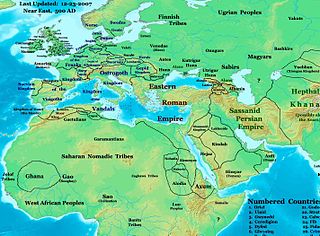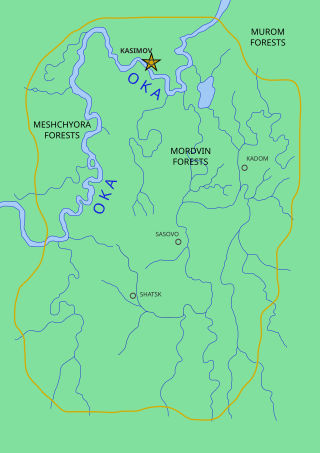
The Tatars, sometimes referred to as Tartars, is an umbrella term for different Turkic ethnic groups bearing the name "Tatar". Initially, the ethnonym Tatar possibly referred to the Tatar confederation. That confederation was eventually incorporated into the Mongol Empire when Genghis Khan unified the various steppe tribes. Historically, the term Tatars was applied to anyone originating from the vast Northern and Central Asian landmass then known as Tartary, a term which was also conflated with the Mongol Empire itself. More recently, however, the term has come to refer more narrowly to related ethnic groups who refer to themselves as Tatars or who speak languages that are commonly referred to as Tatar.

The Sabirs (Savirs, Suars, Sawar, Sawirk among others; were a nomadic Turkic equestrian people who lived in the north of the Caucasus beginning in the late-5th -7th century, on the eastern shores of the Black Sea, in the Kuban area, and possibly came from Western Siberia. They were skilled in warfare, used siege machinery, had a large army and were boat-builders. They were also referred to as Huns, a title applied to various Eurasian nomadic tribes in the Pontic-Caspian Steppe during late antiquity. Sabirs led incursions into Transcaucasia in the late-400s/early-500s, but quickly began serving as soldiers and mercenaries during the Byzantine-Sasanian Wars on both sides. Their alliance with the Byzantines laid the basis for the later Khazar-Byzantine alliance.

Volga Bulgaria or Volga–Kama Bulgaria was a historical Bulgar state that existed between the 7th and 13th centuries around the confluence of the Volga and Kama River, in what is now European Russia. Volga Bulgaria was a multi-ethnic state with large numbers of Bulgars, Volga Finns, Varangians and many East Slavs. Its strategic position allowed it to create a local trade monopoly with Norse, Cumans, and Pannonian Avars.

The Chuvash people, plural: чӑвашсем, çăvaşsem; Russian: чува́ши ) are a Turkic ethnic group, a branch of the Onogurs, native to an area stretching from the Volga-Ural region to Siberia. Most of them live in Chuvashia and the surrounding areas, although Chuvash communities occur throughout the Russian Federation. They speak Chuvash, a unique Turkic language that diverged from other languages in the family more than a millennium ago. Among the Chuvash believers, the majority are Eastern Orthodox Christians.

The Khanate of Kazan was a medieval Tatar Turkic state that occupied the territory of former Volga Bulgaria between 1438 and 1552. The khanate covered contemporary Tatarstan, Mari El, Chuvashia, Mordovia, and parts of Udmurtia and Bashkortostan; its capital was the city of Kazan. It was one of the successor states of the Golden Horde, and it came to an end when it was conquered by the Tsardom of Russia.

Qasim Khanate or Kingdom of Qasim or Khanate of Qasım was a Tatar-ruled khanate, a vassal of Russia, which existed from 1452 until 1681 in the territory of modern Ryazan Oblast in Russia with its capital at Kasimov, in the middle course of the Oka River. It was established in the lands which Grand Prince Vasily II of Moscow presented in 1452 to the Kazan prince Qasim Khan, son of the first Kazan khan Olug Moxammat.
The Old Tatar or Old Bashkir was a literary language used by some ethnic groups of the Volga-Ural region from the Middle Ages until the 19th century.
The Onoghurs or Onoğurs or Oğurs, were Turkic nomadic equestrians who flourished in the Pontic–Caspian steppe and the Volga region between 5th and 7th century, and spoke the Oghuric language.
Burtas were a tribe of uncertain ethnolinguistic affiliation inhabiting the steppe region north of the Caspian Sea in medieval times. They were subject to the Khazars.
Suar was a medieval Volga Bulgarian city, the capital of Suar Principality in 948–975.
The Mongol invasion of Volga Bulgaria lasted from 1223 to 1236. The Bulgar state, centered in lower Volga and Kama, was the center of the fur trade in Eurasia throughout most of its history. Before the Mongol conquest, Russians of Novgorod and Vladimir repeatedly looted and attacked the area, thereby weakening the Bulgar state's economy and military power. The latter ambushed the Mongols in the later 1223 or in 1224. Several clashes occurred between 1229–1234, and the Mongol Empire conquered the Bulgars in 1236.

The territory of Tatarstan, a republic of the Russian Federation, was inhabited by different groups during the prehistoric period. The state of Volga Bulgaria grew during the Middle Ages and for a time was subject to the Khazars. The Volga Bulgars became Muslim and incorporated various Turkic peoples to form the modern Volga Tatar ethnic group.
Zilant is a legendary creature, something between a dragon and a wyvern. Since 1730, it has been the official symbol of Kazan. This winged snake is mentioned in legends about the foundation of Kazan.
Mishar Yurt was a semi-autonomous principality of the Golden Horde at the border of Moscow, Nizhny Novgorod and Ryazan duchies.
Esegels were an Oghur Turkic dynastic tribe in the Middle Ages who joined and would be assimilated into the Volga Bulgars.
Almış or Almuš, iltäbär of the Volga Bulgars, is believed to have been the first Muslim ruler (emir) of Volga Bulgaria.
Şilki or Šilki or Shilki, or possibly Jilki was a Volga Bulgarian ruler (iltäbär). According to the controversial History of Jaˁfar, Şilki was a descendant of Kubrat of "Old Great Bulgaria" according to the tradition that Volga Bulgaria was established by Kubrat's son, Kotrag. Şilki is credited with promoting the unification of the Bulgar tribes in the area, but the events of his reign are obscure or unverifiable. He is sometimes assumed to have initiated the conversion of the Volga Bulgars to Islam. His son Almış, the most famous Volga Bulgar ruler, was definitely a Muslim, and received a caliphal embassy led by Aḥmad ibn Faḍlān. Almış was given the new Muslim name Jaˁfar ibn ˁAbdallāh, which in turn has led to the belief that Şilki bore the Muslim name ˁAbdallāh. However, "son of ˁAbdallāh" was a traditional filiation given to new converts to Islam, replacing the name of their non-Muslim fathers with the name of the father of the Islamic prophet Muḥammad.
The history of Chuvashia spans from the region's earliest attested habitation by Finnic peoples to its incorporation into the Russian Empire and its successor states.
Suar may refer to: